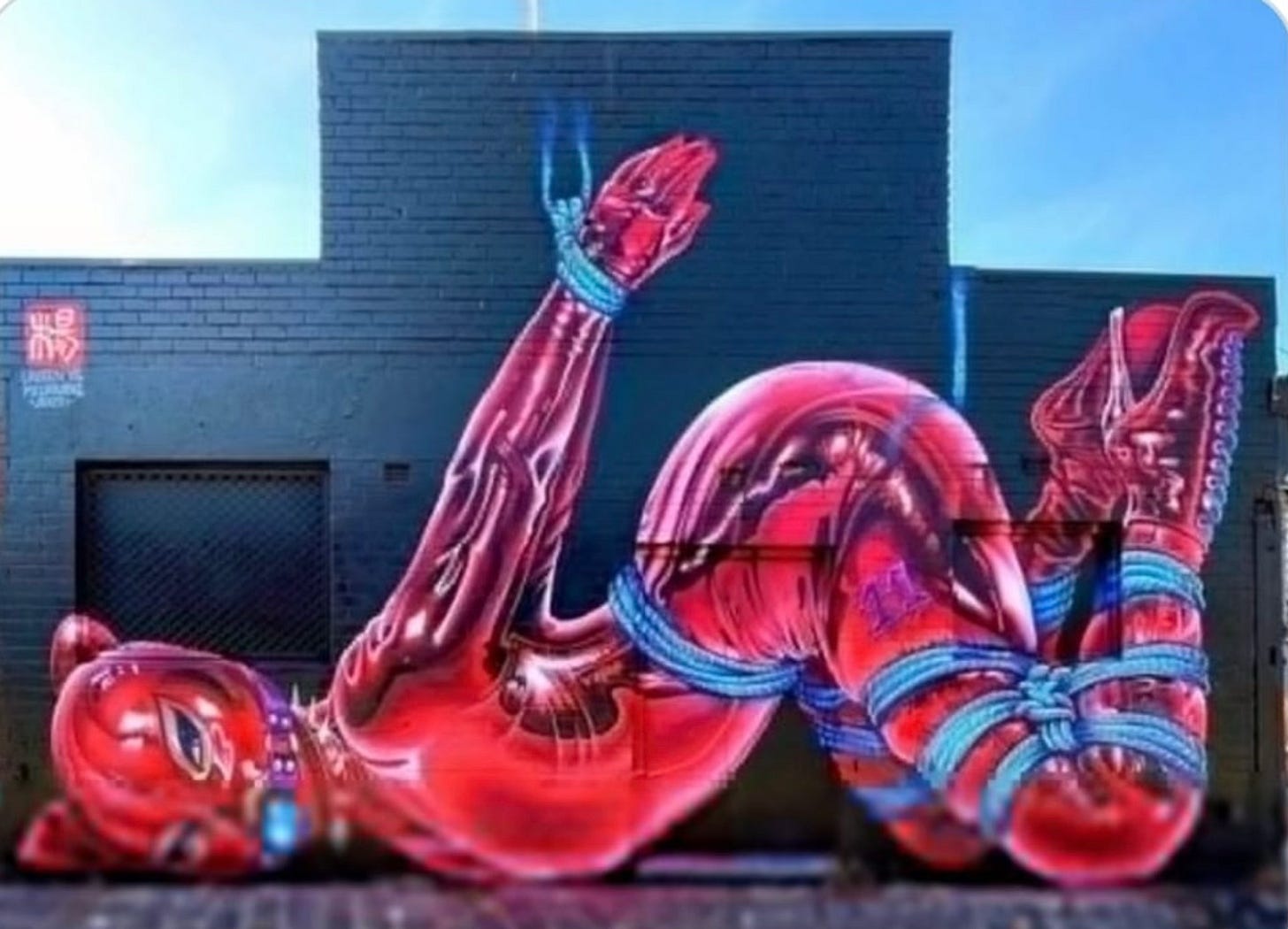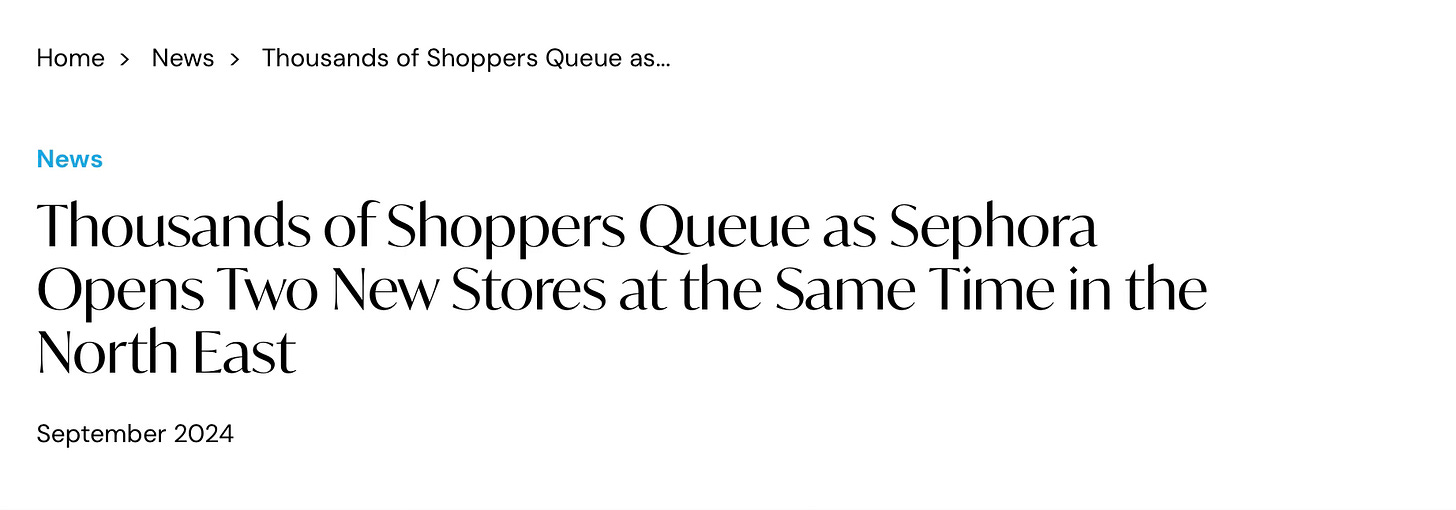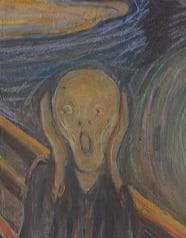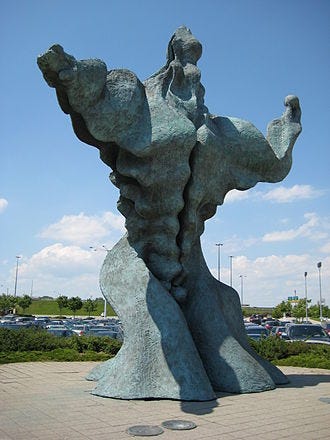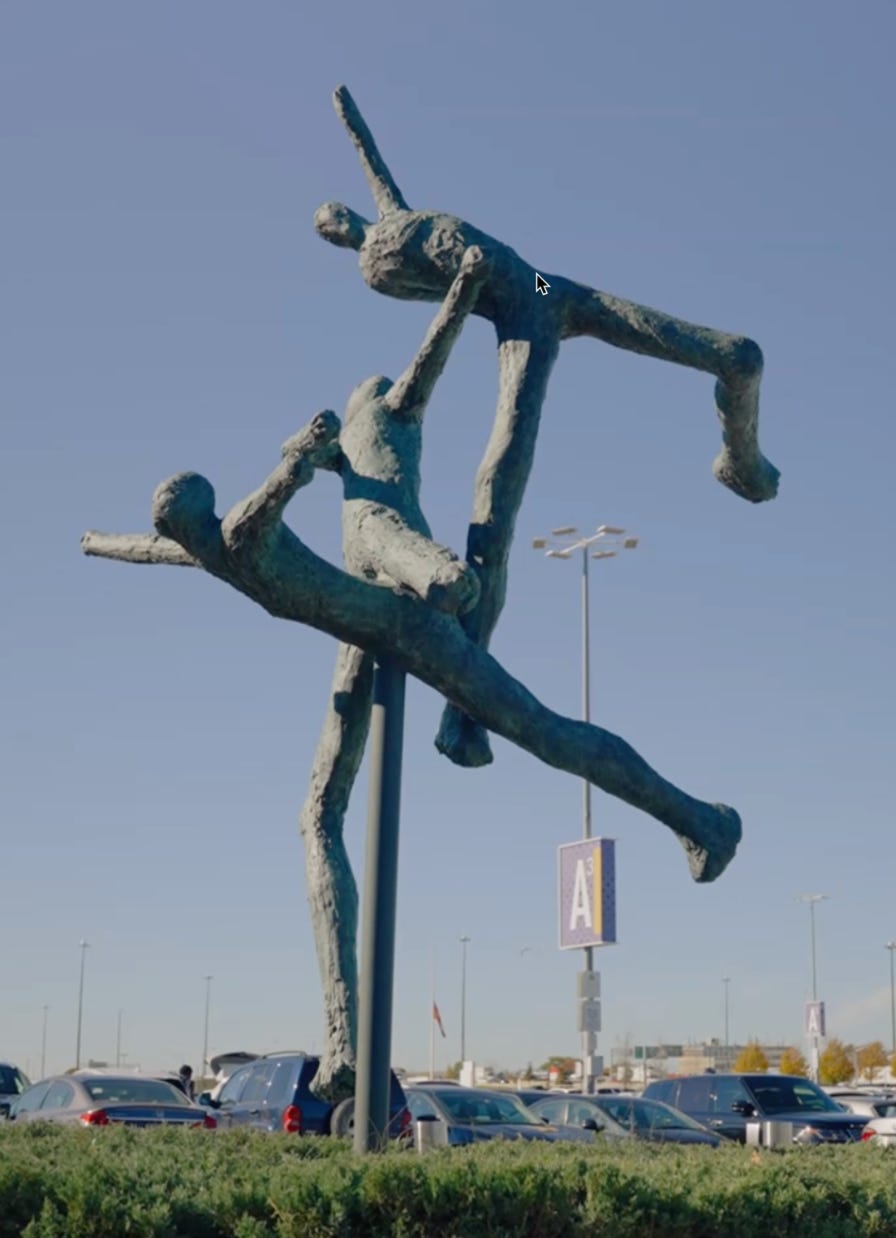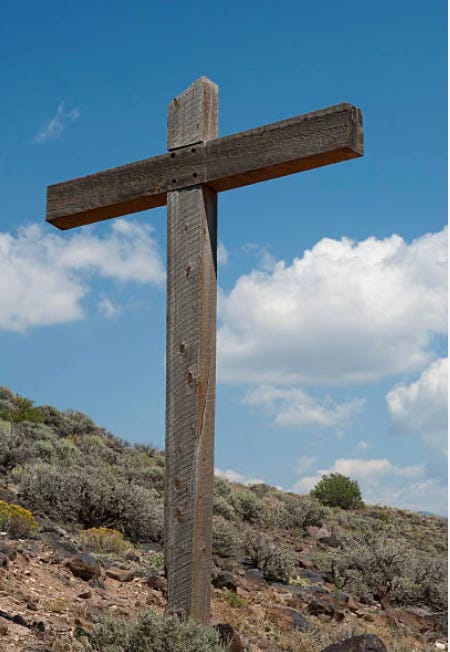What our public art says about us: empty ...and adrift
Christians should start to reclaim the commanding heights of our culture -- which is to say those material things in high, prominent places that demand our attention.
PRO-SCRIPT/ADDENDUM
I posted this Substack and my sister thought I was referring to this perverse monstrosity — that passes for public art in Australia this week.
Kicking up a fire-storm on Twitter with many other examples, like this from Denver.
It’s not a surprise. Pornography is just the most basic face of materialism — the weaponization of the amygdala in an increasingly left-brained, ‘thing oriented’, parts-preoccupied, present-trapped culture of immediate gratification.
PROLOGUE
Ok — a bit of a rant this one. I had to wait for a couple of hours at a shopping mall in Toronto. It’s a ghastly place at the best of times. Grumpy already and disappointed that the only bookshop (Indigo) sold more pink stationary and matching cushions than actual books, I was in just the right frame of mind to enjoy the array of art works on display for the edification of the shopping public. It turns out that passive defecation of abstract art on corporate-demand, matches perfectly the autopilot shoppers. Once self-driving cars can play-fetch for AI self-stocking refrigerators and wardrobes, there won’t need to be any actual people involved at all. And maybe the robots will succeed where human beings fail, and actually find the well-hidden symbolism of Albert Paley’s ‘Ambiguous Response’ — but more of that later.
“That’s not art” — sometimes Alf, the landlord in the King’s Head, actually has a point
It’s a hardly an original whinge. One day in the late 1980s, at the height of my atheism and left-activism, the Metro Centre opened in Gateshead. ‘The biggest shopping centre in Europe’. Mammon had arrived in style. Geordie-nation was duly impressed. An 11 mile queue testified to the faith. Napoleon quipped that we were a nation of shopkeepers. By the end of the 20th century, we had become a nation of shoppers. And apparently we still are. A new store opening still creates a frenzy: “Thousands queue as Sephora opens TWO new stores at the SAME TIME in the North East”
Perhaps if the new Pope Leo XIV visits he will be able to muster a whiff of the same enthusiasm.
The idea that the shopping mall has become the new temple is hardly original. The market has always been coupled with the church square. For a thousand years, the liturgical cycle patterned public space; and the market society was embedded and nestled within the shadow of sacred architecture. The unconscious pull of this structure persisted into the 19th century. But now that unabashed materialism, commerce and consumption have conquered the agora and banished Christianity to the margins of private, individual choice — a domain for eccentrics rather than model citizens — the new order has a problem. The social order needs a sacred order. It requires taboos, rituals and public statements — a simulacrum of metaphysical gravitas wrapped up in a serious aesthetic. And so, here it is.
The image at the top is ‘Ambiguous Response’ (2013) by Albert Paley. It stands outside the entrance of Toronto’s Yorkdale Mall. Talk about a misnomer. My response was certainly anything but ‘ambiguous.’ Wretching despondency is closer to the mark. I mean LOOK at it.
It’s a nothing. Marshmallow hot chocolate has more form and makes a greater statement. Apparently there is a rationale for this three dimensional beige.
the 20-foot sculpture ”Ambiguous Response” by Albert Paley was originally one of 13 monumental sculptures created and exhibited on Park Avenue in New York City in 2013. The sculptures were conceived to be site sensitive to their urban surroundings and adjacent landscapes.
This is the monumental ambition of the post-Christian West: to be site sensitive to urban surroundings and adjacent landscapes.
Who writes this stuff? How about a little transposition?
“Our brand of ACME coffee is designed to be taste-sensitive to the oesophageal context”
Or:
“As a music station in the elevator market segment, we purvey soundscapes that are appropriate for the auditory context of sophisticated early 21st century metropolitan living”
What are these people on? The sooner that A.I. stops actual human beings sullying themselves in this way, the better. I mean listen to the elaboration.
‘When people are experiencing the sculpture, they are contextually relating to the architecture, the dynamism of the pedestrian passage, vehicular traffic, and the ambiance of Yorkdale. It is my hope that the sculpture’s presence helps define a place in memory and identity of place.’
But despite the best efforts of the marketing department —’Yorkdale’s collection of internationally acclaimed 20th century art provides shoppers with a rich cultural experience and makes museum-quality art accessible to all’ —the truth is that nobody cares.
The costly monstrosity makes no more visual or aesthetic impact on the tens of thousands of shoppers than the fleck pattern in the polished concrete urinal floor.
Sure — if I’m doing a No. 2 and my phone has died, and I’m staring intently at the flecks, I might wonder vaguely if the pink colour is more terracotta and what a Roman centurion might have thought if transported by a time-machine to the same cubical. I’m guessing he would have been more impressed by the automated flush than the floor. And I’m pretty sure that ‘Ambiguous Response’ would have left him perplexed perhaps — for about a nanosecond, until someone showed him an iPhone; which is to say like pretty much everyone else on this plateau of self-dumbification.
Making this kind of crap accessible to all is like making the napkins at McDonalds free of charge or celebrating the fact that everyone can watch re-runs of Friends. A civilizational statement and strategy it is not. Our public art is so bad as to be invisible. It can't induce even a yawn. It is empty because we have drained our shared material culture of every fleck of meaning. I was going to say ‘vacuous’ but the marketing department would seize on a word like that and infuse it with faux meaning: ‘the piece speaks to the vacuum of interior space, the amorphous and untapped potential of our inner …..’. But we all know the truth. It is all just bollocks — like Tim Horton’s coffee.
How about this one by another corporate artist.
This 21 ft bronze, Universal Man Gerald Gladstone (1976) was originally located in a ‘prominent location at the foot of the CN Tower’ with the intent of emphasizing ‘the human aspects of the project’.
I’m not even doing to dignify the idea of ‘human aspects’ with scorn. Gladstone was supposedly inspired by Da Vinci’s Vitruvian man. It cost nearly 3/4 million dollars in today’s’ money. Serious art has always cost money. Carravagio was sponsored by Cardinal Francesco Maria del Monte. In Florence the Medici banking dynasty funded works by artists like Michelangelo, Botticelli and of course Gladstone’s muse Leonardo da Vinci.
What has changed is not the levels of skill — although I think it would be difficult to argue that any of the 20th century modernist sculptors achieved anything like the heights of their Renaissance, Gothic or medieval predecessors. The problem is rather a lack of anything to say, and the absence of any aesthetic constraints. Throughout the medieval period and into the Renaissance, the highs of Western artistic expression channelled a continuing dialogue with Christianity, with the Church and with a transcendent God. Even as art moved closer — like a moth to the flame —towards ‘art for art’s sake’, it retained this iconic window to something greater than humanity. And in doing so the aesthetics of Christendom nurtured and enhanced our humanity. Even the architecture, stained glass and ornamentation of a modest village church was rich in layers of symbolic association that could be read by different audiences —literate, illiterate, high or low born — at a variety of levels. Statuary, paintings and frescoes that adorned places of public assembly were in the same way richly meaningful — not only evoking ‘obvious’ Biblical stories and themes, and the inexorable liturgical cycle of feast-days and celebrations, but also context-dependent patina of local culture and politics, family genealogies, national conflict etc
Moving forward, Graham Coughtry’s ‘The Tritons’ (1964) was commissioned to celebrate the completion of the Yorkdale in 1964. It features ‘three humanoid figures intertwined as they strive to reach the top.’
.
Coughtry was instrumental in bringing abstract art to Canada — enough said. He was on the side of progress. Is it possible to think of a more vacuous artistic mission statement?: Three humanish — not-quite human? post-human? — figures striving to come out on top? Aside from the fact that they look like an A-level art project in plasticine, is there not something telling, and indeed sinister (even back in 1964) about this preoccupation with being human-ish? It implies that our humanity can be amended, or supplemented….or that we can improve ourselves; that there might be an ‘essential humanity’ that doesn’t depend on our particular bodies or capabilities, but is rather a potential that can realized, even as we actual humans are superseded. In other words, all of this art is basically programmatically transhumanist. It’s one of the oldest stories in the world: the tower of Babel, Prometheus, Faust, Nietzsche. Not satisfied with human limitations — the very limitations by the way that make any kind of creativity possible — some metaphysical entrepreneurs decide that we can do better without God.
This is gnosticism — to the extent that, in the end, it dismisses the material reality of creation and in particular our body-souls, created in the image of God. The lack of skill not withstanding, this is why the Tritons and the Universal Man look like set rejects from the 1950s B movie.
And it is transhumanism because human beings and humanity don’t feature in the telos of this version of modernity.
What is to be done?
Lenin was a murderous psychopath, for sure. But he had a plan. He jumped out of that box car in St Petersburg and made history. Grotesque, empty, meaningless corporate sponsored public art is a matter of life and death. It’s a very clear sign that our culture and our civilization is dying. It has been taken over by a set of diabolical ideas that will — if they are allowed — oversee the destruction of humanity. It will be a destruction through a thousand cuts of self improvement. The destination has been made very clear by the confused self-butchery engendered by the transgender cult. The normalization of drug use, the destruction of the family, plummeting birth rates, the displacement of millions of workers by A.I. and a coercive totalitarian techno-surveillance state are all steps along the way.
But one of the first canaries was the total victory of modern art — first of all in its highbrow intellectual version, then in the mass culture of kitsch and finally in the empty, post-modern, expression(othing)ism of the kind of corporate abstract art that decorates shopping malls.
So what can we do?
Don’t shop in these places. It won’t achieve anything, but it will save you the pain and misery of car-park art, shit coffee and fake bookshops.
Don’t attend ugly churches. If Christians can’t demonstrate the link between goodness, truth and beauty in our own buildings — then we might as well give up. Let’s build beautiful churches that will take more than a lifetime to complete.
Perhaps we should be a little more ‘in your face’ about pushing Christian iconography and statuary in public spaces. We may no longer have access to the public square. But we can buy adjacent spaces — and build monumental, edifying, uplifting and beautiful icons of our faith and 2000 years of artistic expression predicated on our humanity as ‘creatures’ — creations of the one, true, and universal, loving God.
Addendum: I’m going to chop down two great big pines, hand mill the lumber, and build an enormous cross to and in a prominent position overlooking the road.




